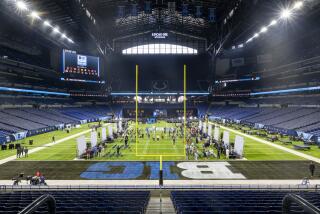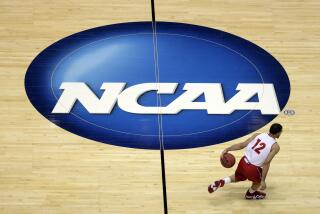NFL Told to Allow Younger Players
The National Football League -- the lone holdout against a youth movement that has swept through major professional sports -- lost an antitrust suit in federal court Thursday and was ordered to open its doors to younger players.
The lawsuit was filed by suspended Ohio State running back Maurice Clarett, who sought to make himself eligible for the NFL draft in April but had been thwarted by a league rule that excludes players until three years after high school graduation.
For the record:
12:00 a.m. Feb. 8, 2004 For The Record
Los Angeles Times Sunday February 08, 2004 Home Edition Main News Part A Page 2 National Desk 1 inches; 29 words Type of Material: Correction
Football -- An article in Friday’s Section A about Maurice Clarett’s antitrust suit against the NFL misspelled the last name of Mel Helitzer, an Ohio University professor, as Helitizer.
The 20-year-old Clarett has played only one season of college football.
In a 71-page opinion issued from her New York courtroom, U.S. District Judge Shira Scheindlin said the league’s eligibility rule violated antitrust laws and “must be sacked.”
“The NFL has not justified Clarett’s exclusion by demonstrating that the rule enhances competition,” she wrote. “Indeed, Clarett has alleged the very type of injury -- a complete bar to entry into the market for his services -- that the antitrust laws are designed to prevent.”
The opinion was broad enough that NFL executives conceded that any number of the best freshmen and sophomores in the college game, and maybe a few high school seniors, might declare themselves eligible for the draft in coming days.
But even as the league reopened the draft -- the deadline for entry passed last month -- NFL executives said they would appeal the case and perhaps seek an emergency stay, which could keep Clarett and others in limbo beyond April.
If the ruling stands, Clarett would drag the NFL into an era that has seen teenagers flourish in a variety of professional sports.
Last spring, LeBron James joined the likes of Kobe Bryant and Kevin Garnett by jumping from high school to the National Basketball Assn. He attracted a $90-million sneaker endorsement in the process.
Fourteen-year-old golfer Michelle Wie recently competed against men in a PGA Tour event. Freddy Adu, also 14, signed with Major League Soccer. Pro baseball and hockey teams have drafted players out of high school for decades, often sending these prospects to the minor leagues for seasoning.
Clarett said of his victory: “It gives a whole lot of kids an opportunity to choose a different path, just like every other sport.”
Yet there was debate about how many of those would seek to make themselves available for the draft, and how they would be greeted by the NFL.
“The floodgates just got opened,” said Artie Gigantino, a member of the Oakland Raiders front office and former USC assistant coach.
But Gil Brandt, a former Dallas Cowboy player personnel director who helped assemble several Super Bowl champions, predicted that teams would be leery of young talent.
“You have to be in training camp to see these college players come in, thinking, ‘I’m as strong as any of these guys,’ ” Brandt said. “Boy, the first thing they learn is they’re not as strong as guys who have been in the league two or three years. Physical and mental maturity are so important.”
Football has always set itself apart from other sports by saying that the game’s inherent violence demands such maturity. For decades, players have been expected to progress through the college system.
On Thursday, NFL Executive Vice President Jeff Pash said league statistics showed that athletes who played four years of college football had longer and more lucrative professional careers. The three teams with the most graduates on their rosters -- the Indianapolis Colts, Carolina Panthers and Super Bowl-champion New England Patriots -- finished the season atop the standings, he said.
“The people who will be hurt are players who for one reason or another try to make the jump from college to the NFL when they’re not ready to do so,” Pash said. “For many of them, they’ll lose their only opportunity at a college education and they’ll lose their opportunity to play in the NFL.”
At least one legal expert, Fordham University law professor Mark Conrad, said of Scheindlin’s ruling, “I think she read the antitrust laws pretty broadly, and I think this case would call for an appeal.”
Clarett’s attorney, Alan C. Milstein, had argued that the rule violated the Sherman Act by unfairly restraining a large segment of players from earning a living. Many sports business experts agreed.
“In all the other sports, like basketball with LeBron James, these kids have proved they are capable of playing,” said Mel Helitizer, a professor of sports administration at Ohio University. “Football is the only one trying for this masquerade. And the truth is, it’s restraint of trade.”
College football also had a stake in the ruling.
Now, star players might jump to the professional league earlier and in greater numbers, thus diluting the college game.
There are questions about how recruiters would operate in an environment where the best high school players might accept a scholarship offer in February and then make themselves available for the draft in April, leaving their chosen schools empty-handed.
As it stands, college players are allowed to explore their prospects in the NFL draft. How would the NCAA handle high school players doing this?
“That’s a huge question,” Grant Teaff, executive director of the American Football Coaches Assn., said this week. “It raises a lot of red flags.”
The NBA dealt with such complications in 1971, after losing a Supreme Court case brought by teenage star Spencer Haywood. The ruling opened basketball’s draft to underclassmen.
“I was in Iraq this summer for eight days with some retired NBA players and the USO and I saw 18-year-olds fighting for our country,” Haywood said Thursday, according to Associated Press. “I’d love somebody to explain to me how we can send an 18-year-old to war, but we can’t to the NFL.”
Clarett paused when asked about his courtroom victory and its implications for football.
“I guess somebody has to give it a try,” he said.
Now a sophomore listed at 6 feet and 230 pounds, he is an unlikely crusader who came to his position through a series of successes and controversies.
Months out of high school in 2002, he became the first freshman in Ohio State history to start the season at tailback. His 1,237 yards and 18 touchdowns helped the Buckeyes to the national championship that season.
But the following spring, he was accused of lying on a campus police report, exaggerating the value of items stolen from a car he had borrowed. The university subsequently suspended him from playing football amid allegations he had violated NCAA rules by improperly accepting thousands of dollars from a family friend, then lying about it to investigators.
The criminal case was resolved last month when Clarett pleaded guilty to a lesser charge and was fined $100. The suspension stands, and Ohio State has yet to apply to the NCAA for his reinstatement.
Throughout his civil suit, Clarett gave conflicting indications about whether he wanted to turn professional or return to the Buckeyes.
On Thursday, he declined to commit himself. Milstein said his client needed to preserve the option of returning to Ohio State next season should an appeal keep him out of the draft.
Clarett’s preference, however, may have been revealed when he was asked whether he was prepared to play at the next level.
“I’m ready,” he said. “Like every kid, I’m ready.”
More to Read
Go beyond the scoreboard
Get the latest on L.A.'s teams in the daily Sports Report newsletter.
You may occasionally receive promotional content from the Los Angeles Times.











